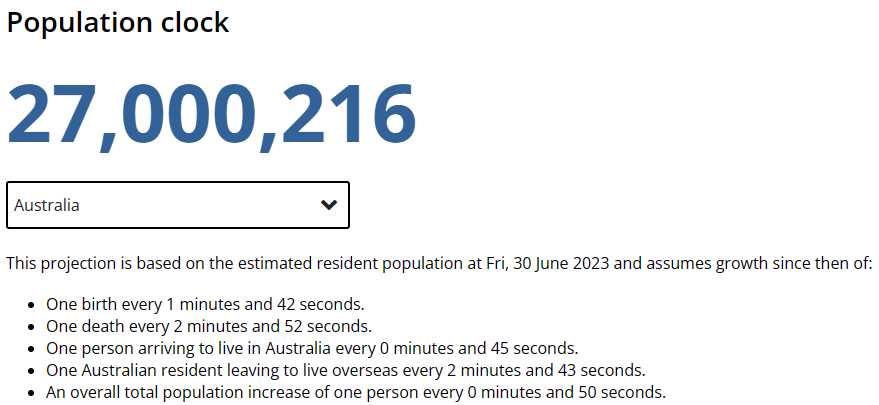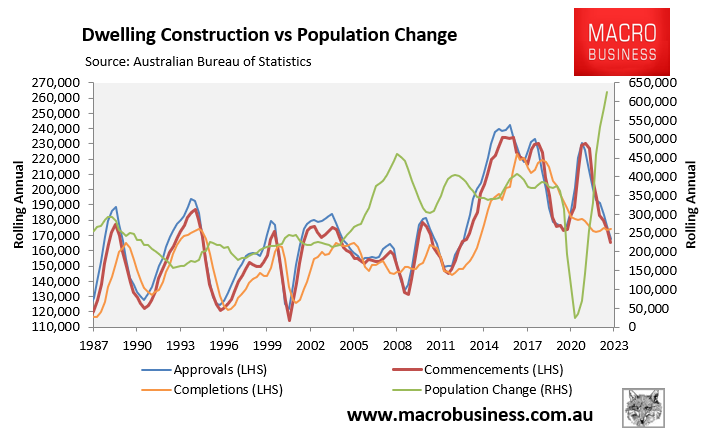The Australian Bureau of Statistics’ (ABS) Population Clock shows that Australia’s population has surpassed 27 million people, driven by record net overseas migration:

McCrindle noted that Australia “has reached 27 million, more than thirty years ahead of predictions”:
“Australia’s population has increased by 624,100 over the past 12 months, equivalent to adding the population of the entire state of Tasmania (572,800) in just one year”.
“Based on the latest annual growth rate of 2.4%, Australia’s population will be 41 million by 2042, 16 million more than the 2002 forecasts”.
“It is the balance of 737,200 overseas arrivals and 219,100 departures which has led to record growth”.
“Based on Treasury’s Intergenerational Report 2002 forecast, Australia’s population was only projected to be 23.4 million by this point. The 2002 report also forecasts a national population of 25 million in 2037”.
“However, this milestone was reached 19 years early, in August 2018. In these forecasts prepared in 2002, Australia’s population growth was projected to slow into the 2000s from 1.2% at the turn of the Millennium, to around 0.6% in the 2020s, 0.4% in the 2030s, and just 0.2% in the 2040s”.
“However, instead of slowing growth, the population growth has accelerated over recent years”.
“In the Treasury’s 2002 population model, Australia’s population was to hit 25.3 million by the end of the projection period in 2042. The latest population milestone of 27 million has been reached more than 30 years ahead of the 2002 forecast”.
The reason for the faster than projected population growth is explained by the next chart:

The original Intergeneration Report in 2001 forecast that we’d have 90,000 a year net overseas migration. And that was the steady-state level assumed in the report.
The federal government then ramped immigration, which has led to Australia’s population ballooning by around 7 million people since 2002, smashing those earlier projections.
The New Daily noted this week that “Australia will need another 1.5 million houses in the next six years to keep up with demand”.
But KPMG director of demographics and urban economics, Terry Rawnsley, believes the current number of dwelling approvals and commencements across the major capital cities will only add to housing supply enough to keep the national rental vacancy rate sitting around record low levels of around 1%.

Source: CoreLogic
This necessarily means that Australia’s housing shortage will continue for several more years.
Rawnsley stated that the cost of building a home has increased by around 30% in the last 24 to 36 months compared to pre-COVID levels, owing primarily to pandemic-induced supply chain challenges and worker shortages, as well as energy price increases caused by the Russia-Ukraine war.
The RBA’s rapid interest rate hikes have also put pressure on developers and homebuyers alike.
“We’re in this perfect storm, where a lot of things are going against the supply of additional housing”, Rawnsley said.
“So that’s why governments and development sectors are trying to work out how to get more housing into the system as quick as we can”.
Given all of the forward-looking housing supply indicators are pointing down amid record population growth (see below chart), there is only one solution to Australia’s housing crisis: slash immigration.

Australia simply cannot build enough homes to keep up with demand. Therefore, population growth (immigration) must be cut hard.

